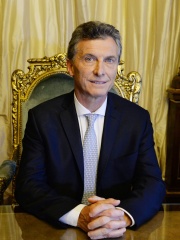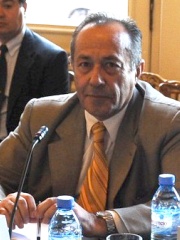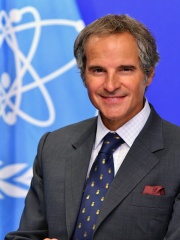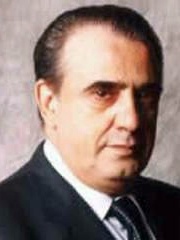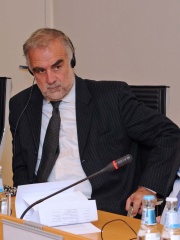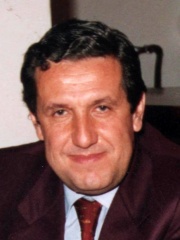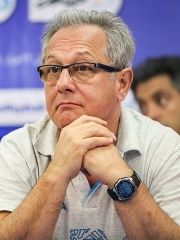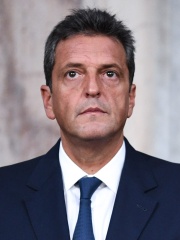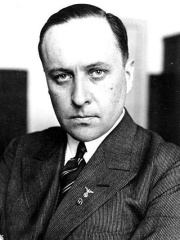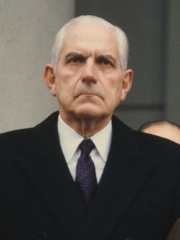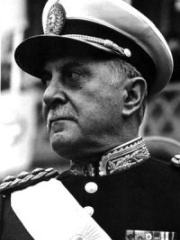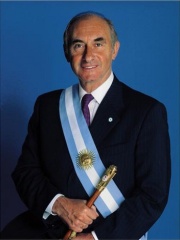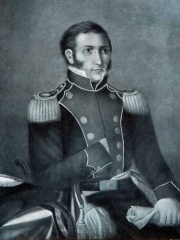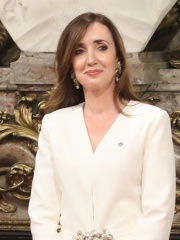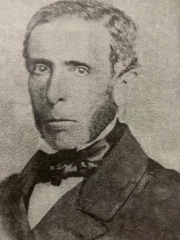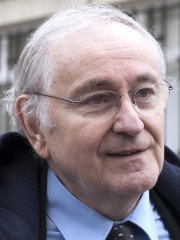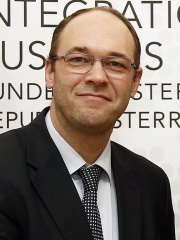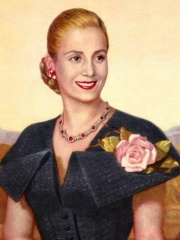
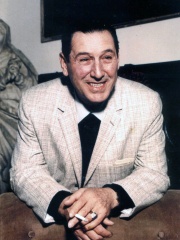
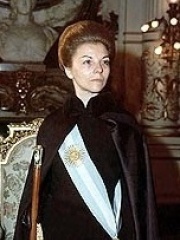
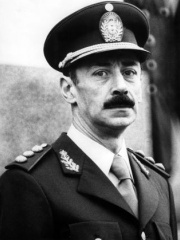
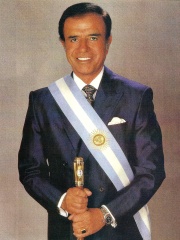
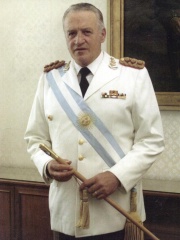
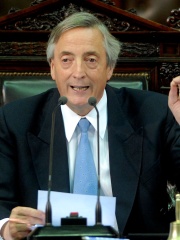
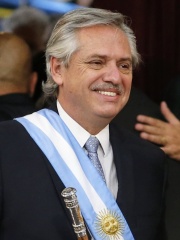
The Most Famous
POLITICIANS from Argentina
This page contains a list of the greatest Argentinean Politicians. The pantheon dataset contains 19,576 Politicians, 90 of which were born in Argentina. This makes Argentina the birth place of the 37th most number of Politicians behind Georgia, and Serbia.
Top 10
The following people are considered by Pantheon to be the top 10 most legendary Argentinean Politicians of all time. This list of famous Argentinean Politicians is sorted by HPI (Historical Popularity Index), a metric that aggregates information on a biography’s online popularity. Visit the rankings page to view the entire list of Argentinean Politicians.

1. Eva Perón (1919 - 1952)
With an HPI of 76.92, Eva Perón is the most famous Argentinean Politician. Her biography has been translated into 92 different languages on wikipedia.
María Eva Duarte de Perón (Spanish pronunciation: [maˈɾi.a ˈeβa ˈðwarte ðe peˈɾon]; née María Eva Duarte; 7 May 1919 – 26 July 1952), better known as just Eva Perón or by the nickname Evita (Spanish: [eˈβita]), was an Argentine politician, activist, actress, and philanthropist who served as First Lady of Argentina from June 1946 until her death in July 1952, as the wife of Argentine President Juan Domingo Perón (1895–1974). She was born in poverty in the rural village of Los Toldos, in the Pampas, as the youngest of five children. In 1934, at the age of 15, she moved to the nation's capital of Buenos Aires to pursue a career as a stage, radio, and film actress. She met Colonel Juan Perón on 22 January 1944 during a charity event at the Luna Park Stadium to benefit the victims of an earthquake in San Juan, Argentina. The two were married the following year. Juan Perón was elected President of Argentina in June 1946; during the next six years, Eva Perón became powerful within the pro-Peronist trade unions, primarily for speaking on behalf of labor rights. She also ran the Ministries of Labor and Health, founded and ran the charitable Eva Perón Foundation, championed women's suffrage in Argentina, and founded and ran the nation's first large-scale female political party, the Female Peronist Party. In 1951, Eva Perón announced her candidacy for the Peronist nomination for the office of Vice President of Argentina, receiving great support from the Peronist political base, low-income and working-class Argentines who were referred to as descamisados or "shirtless ones" (similar to the term “sans-culottes” during the French Revolution). Opposition from the nation's military and bourgeoisie, coupled with her declining health, ultimately forced her to withdraw her candidacy. In 1952, shortly before her death from cancer at 33, Eva Perón was given the title of "Spiritual Leader of the Nation" by the Argentine Congress. She was given a state funeral upon her death, a prerogative generally reserved for heads of state. Eva Perón has become a part of international popular culture, most famously as the subject of the musical Evita (1976).Cristina Álvarez Rodríguez has said that Evita has never left the collective consciousness of Argentines. Cristina Fernández de Kirchner, the second female president of Argentina (after Isabel Perón), claims that women of her generation owe a debt to Eva for "her example of passion and combativeness".

2. Juan Perón (1895 - 1974)
With an HPI of 75.41, Juan Perón is the 2nd most famous Argentinean Politician. His biography has been translated into 81 different languages.
Juan Domingo Perón (UK: , US: , Spanish: [ˈxwan doˈmiŋɡo peˈɾon] ; 8 October 1895 – 1 July 1974) was an Argentine lieutenant general and politician who served as the 35th President of Argentina from 1946 to his overthrow in 1955, and again as the 45th President from October 1973 to his death in July 1974. He had previously served in several government positions, including Minister of Labour and Vice President under presidents Pedro Pablo Ramírez and Edelmiro Farrell. During his first presidential term (1946–1952), Perón was supported by his second wife, Eva Duarte ("Evita"); they were immensely popular among the Argentine working class. Perón's government invested heavily in public works, expanded social welfare, and forced employers to improve working conditions. Trade unions grew rapidly with his support and women's suffrage was granted with Eva's influence. His government was also known to employ dictatorial tactics; several dissidents were fired, exiled, or arrested, and much of the press was closely controlled. Several high-profile fascist war criminals, such as Josef Mengele, Adolf Eichmann, and Ante Pavelić, were given refuge in Argentina during this time. Perón was re-elected by a fairly wide margin, though his second term (1952–1955) was far more troubled. Eva, a major source of support, died a month after his inauguration in 1952. An economic crisis was ongoing, Perón was accused of having a relationship with a teenage girl, Nelly Rivas, and his plans to legalise divorce and prostitution damaged his standing with the Catholic Church. After he deported two Catholic priests and was mistakenly thought to be excommunicated, pro-Church elements of the Argentine Navy and Air Force bombed Plaza de Mayo in Buenos Aires, where supporters of Perón had gathered, in June 1955. More than 300 civilians were killed in this coup attempt, which in turn prompted violent reprisals against many churches by Perón's supporters. Within months, a successful coup deposed him. During the following period of two military dictatorships, interrupted by two civilian governments, the Peronist party was outlawed and Perón was exiled. Over the years he lived in Paraguay, Venezuela, Panama, and Spain. When the Peronist Héctor José Cámpora was elected president in 1973, Perón returned to Argentina amidst the Ezeiza massacre and was soon after elected president for a third time (12 October 1973 – 1 July 1974). During this term, left- and right-wing Peronists were permanently divided and violence between them erupted, with Perón increasingly siding with the right. His minister José López Rega formed the Argentine Anticommunist Alliance, believed to have committed at least hundreds of extrajudicial killings and kidnappings. Perón's third wife, María Estela Martínez, known as Isabel Perón, was elected as vice president on his ticket and succeeded him as president upon his death in 1974. Political violence only intensified, and she was ousted in 1976, followed by a period of even deadlier repression under the junta of Jorge Rafael Videla. Although they are still controversial figures, Juan and Eva Perón are nonetheless considered icons by the Peronists. The Peróns' followers praised their efforts to eliminate poverty and to dignify labour, while their detractors considered them demagogues and dictators. The Peróns gave their name to the political movement known as Peronism, which in present-day Argentina is represented mainly by the Justicialist Party.

3. Isabel Martínez de Perón (b. 1931)
With an HPI of 70.23, Isabel Martínez de Perón is the 3rd most famous Argentinean Politician. Her biography has been translated into 67 different languages.
Isabel Martínez de Perón (Spanish pronunciation: [isaˈβel maɾˈtines ðe peˈɾon] , born María Estela Martínez Cartas; 4 February 1931) is an Argentine former politician who served as the 46th President of Argentina from 1974 to 1976. She was one of the first female republican heads of state in the world, and the first woman to serve as president of a country. Isabel Perón was the third wife of President Juan Perón. During her husband's third term as president from 1973 to 1974, she served as both Vice President and First Lady of Argentina. Following her husband's death in office in 1974, she served as President for almost two years before the military took over the government with the 1976 coup. Perón was then placed under house arrest for five years before she was exiled to Spain in 1981. After democracy was restored in Argentina in 1983, she was a guest of honor at President Raúl Alfonsín's inauguration. For several years, she was a nominal head of Juan Perón's Justicialist Party and played a constructive role in reconciliation discussion, but has never played any important political role afterwards. Isabel Perón is one of the greatest expressions of the right-wing peronism and mainly of the orthodox peronism. Ideologically, she was considered close to corporate neo-fascism. During her short tenure in office, she relied, at different points in time, on pro-neoliberal capitalism politicians, politicized military, and trade unions.In 2007, an Argentine judge ordered Perón's arrest over the forced disappearance of an activist in February 1976, on the grounds that the disappearance was authorised by her signing of decrees allowing Argentina's armed forces to take action against "subversives". She was arrested near her home in Spain on 12 January 2007. Spanish courts subsequently refused her extradition to Argentina.Since the death of Carlos Menem on 14 February 2021, Perón is the oldest living former Argentine president.

4. Jorge Rafael Videla (1925 - 2013)
With an HPI of 70.10, Jorge Rafael Videla is the 4th most famous Argentinean Politician. His biography has been translated into 63 different languages.
Jorge Rafael Videla ( vid-EL-ə; Spanish: [ˈxoɾxe rafaˈel βiˈðela]; 2 August 1925 – 17 May 2013) was an Argentine military officer and dictator, Commander in Chief of the Army, member of the Military Junta, the 47th President of Argentina, and the 1st President of the National Reorganization Process from 1976 to 1981. His rule, which was during the time of Operation Condor, was among the most infamous in Latin America during the Cold War due to its high level of human rights abuses and severe economic mismanagement. He came to power in a coup d'état that deposed Isabel Perón. In 1985, two years after the return of a representative democratic government, he was prosecuted in the Trial of the Juntas for large-scale human rights abuses and crimes against humanity that took place under his rule, including kidnappings or forced disappearance, widespread torture and extrajudicial murder of activists and political opponents as well as their families at secret concentration camps. An estimated 13,000 to 30,000 political dissidents vanished during this period. Videla was also convicted of the theft of many babies born during the captivity of their mothers at the illegal detention centres and passing them on for illegal adoption by associates of the regime. Videla maintained the female guerrilla detainees allowed themselves to become pregnant in the belief they would not be tortured or executed. On 5 July 2010, Videla took full responsibility for his army's actions during his rule. "I accept the responsibility as the highest military authority during the internal war. My subordinates followed my orders," he told an Argentine court. Videla also sheltered many Nazi fugitives as Alfredo Stroessner did in Paraguay and as Hugo Banzer did in Bolivia; he was sometimes known as the "Hitler of the Pampa" among opponents of his regime. He was under house arrest until 10 October 2008, when he was sent to a military prison.Following a new trial, on 22 December 2010, Videla was sentenced to life in a civilian prison for the deaths of 31 prisoners following his coup. On 5 July 2012, Videla was sentenced to 50 years in civilian prison for the systematic kidnapping of children during his tenure. The following year, Videla died in the Marcos Paz civilian prison five days after suffering a fall in a shower.
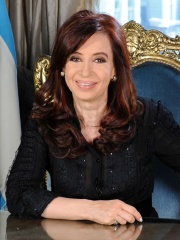
5. Cristina Fernández de Kirchner (b. 1953)
With an HPI of 69.48, Cristina Fernández de Kirchner is the 5th most famous Argentinean Politician. Her biography has been translated into 99 different languages.
Cristina Elisabet Fernández de Kirchner (Spanish pronunciation: [kɾisˈtina eˈlisaβet feɾˈnandes ðe ˈkiɾʃneɾ] ; born Cristina Elisabet Fernández, 19 February 1953), often referred to by her initials CFK, is an Argentine lawyer and politician who served as president of Argentina from 2007 to 2015 and later as vice president of Argentina from 2019 to 2023 under President Alberto Fernández, as well as the first lady of Argentina during the tenure of her husband, Néstor Kirchner, from 2003 to 2007. She was the second female president of Argentina (after Isabel Perón) and the first elected female president of Argentina. Ideologically, she identifies herself as a Peronist and a progressive, with her political approach called Kirchnerism.Born in La Plata, Buenos Aires Province, she studied law at the University of La Plata, and moved to Patagonia with her husband Néstor Kirchner upon graduation. She was elected to the provincial legislature; her husband was elected mayor of Río Gallegos. She was elected national senator in 1995, and had a controversial tenure, while her husband was elected governor of Santa Cruz Province. In 1994, she was also elected to the constituent assembly that amended the Constitution of Argentina. She was the First Lady from 2003 to 2007 after her husband was elected president. Néstor Kirchner did not run for reelection. Instead, his wife was the candidate for the Front for Victory alliance, becoming president in the 2007 presidential election. Her first term of office started with a conflict with the agricultural sector, and her proposed taxation system was rejected. After this she nationalised private pension funds, and fired the president of the Central Bank. The price of public services remained subsidised and she renationalised energy firm YPF as a result. The country had good relations with other South American nations, and strained relations with the western bloc as part of the regional political movement known as pink tide. She also continued her husband's human rights policies, and had a rocky relationship with the press. Néstor Kirchner died in 2010, and she was re-elected for a second term in 2011. She won the 2011 general election with 54.11% of the votes, the highest percentage obtained by any presidential candidate since 1983. The 37.3% difference between votes for hers and the runner-up ticket Binner-Morandini was the second largest in the history of Argentine general elections. She established currency controls during her second term, and the country fell into sovereign default in 2014. She left office in 2015 with approval ratings above 50%.During her two terms as president, several corruption scandals took place and subsequently her government faced several demonstrations against her rule. She was charged for fraudulent low price sales of dollar futures, and later acquitted. In 2015, she was indicted for obstructing the investigation into the 1994 AMIA Bombing, after Alberto Nisman's controversial accusation of a purported "pact" (a memorandum) signed between her government and Iran which was supposedly seeking impunity for Iranians involved in the terrorist attack. In 2017, an arrest warrant issued by Claudio Bonadio for Fernández de Kirchner charged her with "treason", but due to her parliamentary immunity, she did not go to prison, and the treason accusation was later dropped, while other charges related to Nisman's accusation remained. In 2018, she was also indicted for corruption on charges alleging that her administration had accepted bribes in exchange for public works contracts. On 30 September 2020, the federal criminal cassation court confirmed the corruption trials of Fernández de Kirchner, ruling the former president's objections to be inadmissible. After analyzing the claims of the defendants in the case for the never-ratified Memorandum with Iran, on 7 October 2021, the Federal Oral Court 8 declared the case null and void. The judges concluded that there was no crime in the signing of the agreement with Iran, and declared a judicial dismissal of Cristina Kirchner and the other defendants. On 6 December 2022, she was sentenced to six years in prison and a lifetime ban from holding public office for corruption, and has stated her intention to appeal the verdict.

6. Carlos Menem (1930 - 2021)
With an HPI of 67.52, Carlos Menem is the 6th most famous Argentinean Politician. His biography has been translated into 62 different languages.
Carlos Saúl Menem (Spanish pronunciation: [ˈkaɾlos ˈmenen] ; 2 July 1930 – 14 February 2021) was an Argentine lawyer and politician who served as the president of Argentina from 1989 to 1999. Ideologically, he identified as a Peronist and supported economically liberal policies. He led Argentina as president during the 1990s and implemented a free market liberalization. He served as President of the Justicialist Party for thirteen years (from 1990 to 2001 and again from 2001 to 2003), and his political approach became known as Menemism.Born in Anillaco to a Syrian family, Menem was raised as a Muslim, but later converted to Roman Catholicism to pursue a political career. Menem became a Peronist during a visit to Buenos Aires. He led the party in his home province of La Rioja and was elected governor in 1973. He was deposed and detained during the 1976 Argentine coup d'état and was elected governor again in 1983. He defeated the Buenos Aires governor Antonio Cafiero in the primary elections for the 1989 presidential elections. Hyperinflation and riots forced outgoing president Raúl Alfonsín to resign early, shortening the presidential transition. Menem supported the Washington Consensus and tackled inflation with the Convertibility plan in 1991. The plan was complemented by a series of privatizations and was initially a success. Argentina re-established diplomatic relations with the United Kingdom, suspended since the 1982 Falklands War, and developed special relations with the United States. The country suffered two terrorist attacks. The Peronist victory in the 1993 midterm elections allowed him to persuade Alfonsín (by then leader of the opposition party UCR) to sign the Pact of Olivos for the 1994 amendment of the Argentine Constitution. This amendment allowed Menem to run for re-election in 1995, which he won. A new economic crisis began, and the opposing parties formed a political coalition winning the 1997 midterm elections and the 1999 presidential election.He was investigated on various criminal and corruption charges, including illegal arms trafficking (he was sentenced to seven years in prison), embezzlement of public funds (he was sentenced to 4+1⁄2 years to prison), extortion and bribery (in both of which he was declared innocent). His position as senator earned him immunity from incarceration.Menem ran for the presidency again in 2003, but faced with a likely defeat in a ballotage against Néstor Kirchner, he chose to pull out, effectively handing the presidency to Kirchner. He was elected senator for La Rioja in 2005. By the time he died in 2021 at age 90, he was the oldest living former Argentine president. He is regarded as a polarizing figure in Argentina, mostly due to corruption and economic mismanagement throughout his presidency.

7. Leopoldo Galtieri (1926 - 2003)
With an HPI of 66.33, Leopoldo Galtieri is the 7th most famous Argentinean Politician. His biography has been translated into 49 different languages.
Leopoldo Fortunato Galtieri Castelli (Spanish pronunciation: [leoˈpoldo foɾtuˈnato ɣalˈtjeɾi kasˈteli]; 15 July 1926 – 12 January 2003) was an Argentine general who served as President of Argentina from December 1981 to June 1982. Galtieri exercised his control over Argentina as a military ruler during the National Reorganization Process as leader of the Third Junta with Jorge Anaya and Basilio Lami Dozo.Galtieri was chief combat engineer of the Argentine Army and a supporter of the 1976 military coup d'état which helped him become commander-in-chief of the army in 1980. Galtieri overthrew Roberto Viola and was appointed President and established Argentina as a strong Cold War ally of NATO and the United States, while introducing fiscally conservative economic reforms, and increasing Argentine covert support for the anti-communist Contras guerrillas during the Nicaraguan civil war. In domestic policy, General Galtieri continued the Dirty War with the 601 Intelligence Battalion death squad reporting directly to him.Galtieri's declining popularity due to his human rights abuses and the worsening economic stagnation caused him to order an invasion of the Falkland Islands in April 1982. Galtieri was removed from power after Argentina’s defeat by the British armed forces in the Falklands War in June, which led to the restoration of democracy and, in 1986, his court martial prosecution and conviction for war crimes and other offenses. Galtieri was pardoned by Carlos Menem in 1989 and lived in obscurity until his arrest for new charges shortly before his death in 2003.

8. Néstor Kirchner (1950 - 2010)
With an HPI of 65.18, Néstor Kirchner is the 8th most famous Argentinean Politician. His biography has been translated into 66 different languages.
Néstor Carlos Kirchner Ostoić (Spanish pronunciation: [ˈnestoɾ ˈkaɾlos ˈkiɾʃneɾ] ; 25 February 1950 – 27 October 2010) was an Argentine lawyer and politician who served as the President of Argentina from 2003 to 2007. A member of the Justicialist Party, he previously served as Governor of Santa Cruz Province from 1991 to 2003, and mayor of Río Gallegos from 1987 to 1991. He later served as the first ever (and still only) First Gentleman of Argentina during the first tenure of his wife, Cristina Fernández de Kirchner. By the time he died in October 2010, he was First Gentlemen from 2007, President of the Justicialist Party and National Deputy from 2009, and Secretary General of UNASUR from May 2010. Ideologically, he identified himself as a Peronist and a progressive, with his political approach called Kirchnerism.Born in Río Gallegos, Santa Cruz, Kirchner studied law at the National University of La Plata. He met and married Cristina Fernández at this time, returned with her to Río Gallegos at graduation, and opened a law firm. Commentators have criticized him for a lack of legal activism during the Dirty War, an issue he would involve himself in as president. Kirchner ran for mayor of Río Gallegos in 1987 and for governor of Santa Cruz in 1991. He was reelected governor in 1995 and 1999 due to an amendment of the provincial constitution. Kirchner sided with Buenos Aires provincial governor Eduardo Duhalde against President Carlos Menem. Although Duhalde lost the 1999 presidential election, he was appointed president by the Congress when previous presidents Fernando de la Rúa and Adolfo Rodríguez Saá resigned during the December 2001 riots. Duhalde suggested that Kirchner run for president in 2003 in a bid to prevent Menem's return to the presidency. Menem won a plurality in the first round of the presidential election but, fearing that he would lose in the required runoff election, he resigned; Kirchner became president as a result. Kirchner took office on 25 May 2003. Roberto Lavagna, credited with the economic recovery during Duhalde's presidency, was retained as minister of economy and continued his economic policies. Argentina negotiated a swap of defaulted debt and repaid the International Monetary Fund. The National Institute of Statistics and Census intervened to underestimate growing inflation. Several Supreme Court judges resigned while fearing impeachment, and new judges were appointed. The amnesty for crimes committed during the Dirty War in enforcing the full-stop and due-obedience laws and the presidential pardons were repealed and declared unconstitutional. This led to new trials for the military who served during the 1970s. Argentina increased its integration with other Latin American countries, discontinuing its automatic alignment with the United States dating to the 1990s. The 2005 midterm elections were a victory for Kirchner, and signaled the end of Duhalde's supremacy in Buenos Aires Province. Instead of seeking reelection, Kirchner stepped aside in 2007 in support of his wife, who was elected president. He participated in Operation Emmanuel to release FARC hostages, and was narrowly defeated in the 2009 midterm election for deputy of Buenos Aires Province. Kirchner was appointed Secretary General of UNASUR in 2010. He and his wife were involved (either directly or through their close aides) in the 2013 political scandal known as the Route of the K-Money, even though no judicial investigation ever found any proof of wrongdoing by Néstor or Cristina Kirchner. Kirchner died of cardiac arrest on 27 October 2010, and received a state funeral.

9. Alberto Fernández (b. 1959)
With an HPI of 64.92, Alberto Fernández is the 9th most famous Argentinean Politician. His biography has been translated into 73 different languages.
Alberto Ángel Fernández (Latin American Spanish: [alˈβeɾto feɾˈnandes] ; born 2 April 1959) is an Argentine politician, lawyer, and academic who is the President of the Justicialist Party since 2021. He was previously the President of Argentina from 2019 to 2023. He was also the Chief of the Cabinet of Ministers from 2003 to 2008. His tenure as Cabinet Chief remains the longest since the post was created in 1994. Born in Buenos Aires, Fernández attended the University of Buenos Aires, where he earned his law degree at age 24, and later became a professor of criminal law. Ideologically a Peronist, entered public service as an adviser to Deliberative Council of Buenos Aires and the Argentine Chamber of Deputies. In 2003, he was appointed Chief of the Cabinet of Ministers, serving during the entirety of the presidency of Néstor Kirchner, and the early months of the presidency of Cristina Fernández de Kirchner. A member of the Justicialist Party, a Peronist party, Fernández was the party's candidate for the 2019 presidential election under the leftist Frente de Todos alliance and defeated incumbent president Mauricio Macri with 48% of the vote. His political position has been described as left-wing. The first two years of his presidency was limited by the COVID-19 pandemic in Argentina, during which he imposed strict lockdown measures to suppress the spread of the disease, and a debt crisis inherited from his predecessor. While the economy recovered in 2021–22, inflation rose to 100% (the highest since 1991). His approval ratings have been constantly low throughout his presidency, only in few certain occasions over 50% approval rate, with disapproval ratings from 60% to 80%.According to British newspaper The Economist, Fernández was considered "a president without a plan", and his presidency to be a "weak administration", alluding to his lack of independent decision-making. Instead, his decisions were under heavy influence of Vice President and former President Cristina Fernández de Kirchner, also leader of the coalition, whom Fernández himself described as a "permanent source of consultation". In April 2023, Fernández announced that he decided to not seek reelection to the presidency in the 2023 presidential election. He was succeeded by Javier Milei on 10 December 2023.
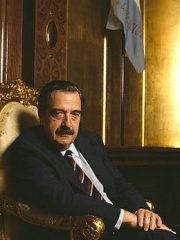
10. Raúl Alfonsín (1927 - 2009)
With an HPI of 64.27, Raúl Alfonsín is the 10th most famous Argentinean Politician. His biography has been translated into 58 different languages.
Raúl Ricardo Alfonsín (Spanish pronunciation: [raˈul alfonˈsin] ; 12 March 1927 – 31 March 2009) was an Argentine lawyer and statesman who served as President of Argentina from 10 December 1983 to 8 July 1989. He was the first democratically elected president after the 7-years National Reorganization Process. Ideologically, he identified as a radical and a social democrat, serving as the leader of the Radical Civic Union from 1983 to 1991, 1993 to 1995, 1999 to 2001, with his political approach being known as "Alfonsinism". Born in Chascomús, Buenos Aires Province, Alfonsín began his studies of law at the National University of La Plata and was a graduate of the University of Buenos Aires. He was affiliated with the Radical Civic Union (UCR), joining the faction of Ricardo Balbín after the party split. He was elected a deputy in the legislature of the Buenos Aires province in 1958, during the presidency of Arturo Frondizi, and a national deputy during the presidency of Arturo Umberto Illia. He opposed both sides of the Dirty War, and several times filed a writ of Habeas corpus, requesting the freedom of victims of forced disappearances, during the National Reorganization Process. He denounced the crimes of the military dictatorships of other countries and opposed the actions of both sides in the Falklands War as well. He became the leader of the UCR after Balbín's death and was the Radical candidate for the presidency in the 1983 elections, which he won. After becoming president, Alfonsín sent a bill to Congress to revoke the self-amnesty law established by the military. He established the National Commission on the Disappearance of Persons to investigate the crimes committed by the military, which led to the Trial of the Juntas and resulted in the sentencing of the heads of the former regime. Discontent within the military led to the mutinies of the Carapintadas, leading him to appease them with the full stop law and the law of Due Obedience. He also had conflicts with the unions, which were controlled by the opposing Justicialist Party. He resolved the Beagle conflict, increased trade with Brazil, and proposed the creation of the Contadora support group to mediate between the United States and Nicaragua. He passed the first divorce law of Argentina. He initiated the Austral plan to improve the national economy, but that plan, as well as the Spring plan, failed. The resulting hyperinflation and riots led to his party's defeat in the 1989 presidential elections, which was won by Peronist Carlos Menem. Alfonsín continued as the leader of the UCR and opposed the presidency of Carlos Menem. He initiated the Pact of Olivos with Menem to negotiate the terms for the 1994 amendment of the Argentine Constitution. Fernando de la Rúa led a faction of the UCR that opposed the pact, and eventually became president in 1999. Following de la Rúa's resignation during the December 2001 riots, Alfonsín's faction provided the support needed for the Peronist Eduardo Duhalde to be appointed president by the Congress. He died of lung cancer on 31 March 2009, at the age of 82, and was given a large state funeral.
People
Pantheon has 98 people classified as Argentinean politicians born between 1757 and 1988. Of these 98, 27 (27.55%) of them are still alive today. The most famous living Argentinean politicians include Isabel Martínez de Perón, Cristina Fernández de Kirchner, and Alberto Fernández. The most famous deceased Argentinean politicians include Eva Perón, Juan Perón, and Jorge Rafael Videla. As of April 2024, 8 new Argentinean politicians have been added to Pantheon including Rafael Grossi, Sergio Massa, and Manuel Dorrego.
Living Argentinean Politicians
Go to all RankingsIsabel Martínez de Perón
1931 - Present
HPI: 70.23
Cristina Fernández de Kirchner
1953 - Present
HPI: 69.48
Alberto Fernández
1959 - Present
HPI: 64.92
Mauricio Macri
1959 - Present
HPI: 63.12
Eduardo Duhalde
1941 - Present
HPI: 60.81
Adolfo Rodríguez Saá
1947 - Present
HPI: 57.89
Rafael Grossi
1961 - Present
HPI: 54.07
Eduardo Camaño
1946 - Present
HPI: 53.75
Luis Moreno Ocampo
1952 - Present
HPI: 52.82
Ramón Puerta
1951 - Present
HPI: 51.24
Julio Velasco
1952 - Present
HPI: 50.99
Sergio Massa
1972 - Present
HPI: 49.94
Deceased Argentinean Politicians
Go to all RankingsEva Perón
1919 - 1952
HPI: 76.92
Juan Perón
1895 - 1974
HPI: 75.41
Jorge Rafael Videla
1925 - 2013
HPI: 70.10
Carlos Menem
1930 - 2021
HPI: 67.52
Leopoldo Galtieri
1926 - 2003
HPI: 66.33
Néstor Kirchner
1950 - 2010
HPI: 65.18
Raúl Alfonsín
1927 - 2009
HPI: 64.27
Richard Walther Darré
1895 - 1953
HPI: 63.69
Reynaldo Bignone
1928 - 2018
HPI: 63.22
Roberto Eduardo Viola
1924 - 1994
HPI: 62.21
Fernando de la Rúa
1937 - 2019
HPI: 62.16
Juan Manuel de Rosas
1793 - 1877
HPI: 61.42
Newly Added Argentinean Politicians (2024)
Go to all RankingsRafael Grossi
1961 - Present
HPI: 54.07
Sergio Massa
1972 - Present
HPI: 49.94
Manuel Dorrego
1787 - 1828
HPI: 49.55
Victoria Villarruel
1975 - Present
HPI: 47.65
José María Linares
1808 - 1861
HPI: 46.00
Eladio Herrera
1930 - 2014
HPI: 44.00
Jacques Cheminade
1941 - Present
HPI: 43.79
Davor Ivo Stier
1972 - Present
HPI: 32.63
Overlapping Lives
Which Politicians were alive at the same time? This visualization shows the lifespans of the 25 most globally memorable Politicians since 1700.

